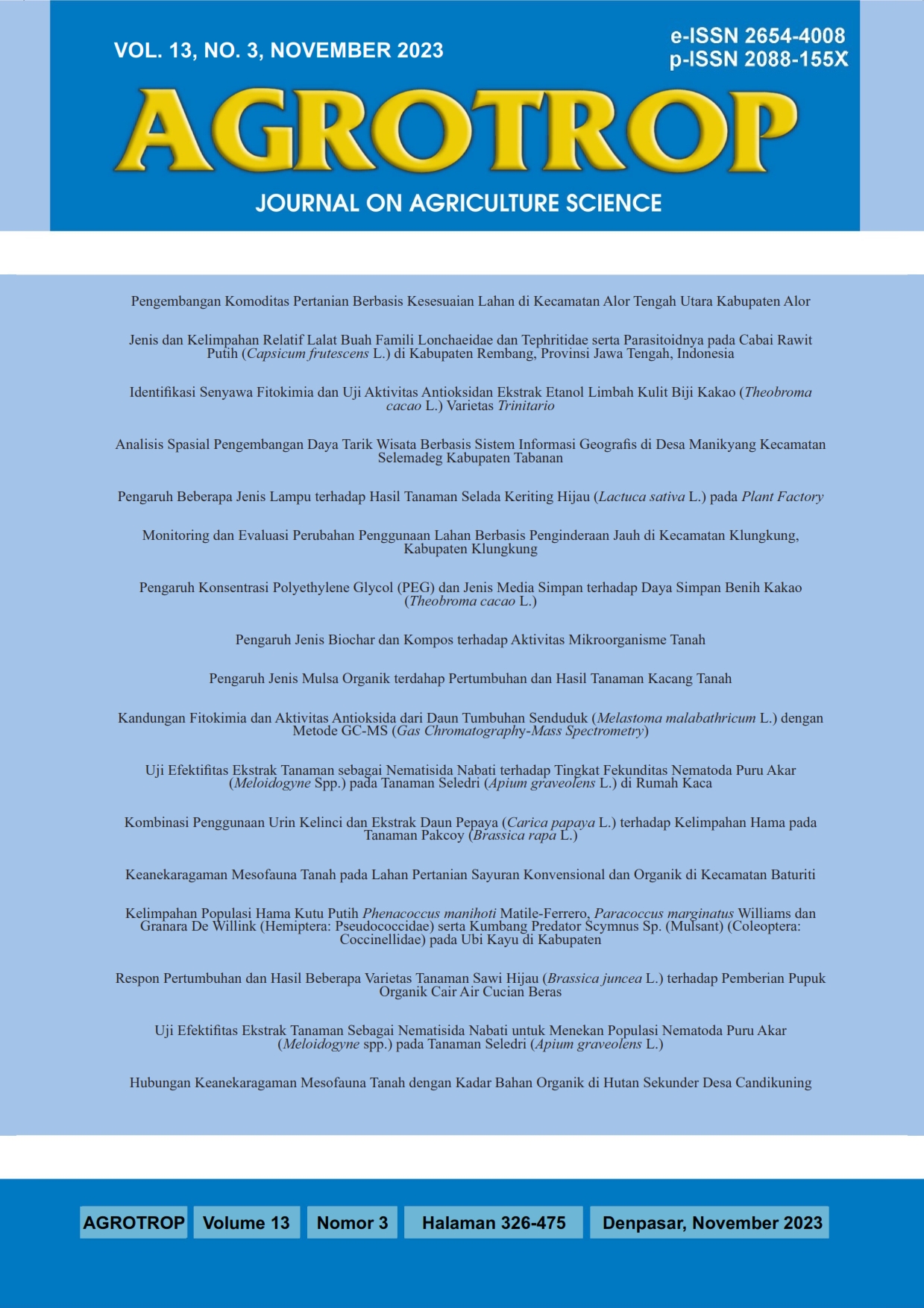Hubungan Keanekaragaman Mesofauna Tanah dengan Kadar Bahan Organik di Hutan Sekunder Desa Candikuning
Abstract
Relationship of Soil Mesofauna Diversity with Organic Little in Secondary Forest in Candikuning Village. Soil mesofauna play important role in maintaining and supporting soil fertility of natural forest. Their population, diversity, and function influenced by organic residues and inhibit by disturbance on the habitat, i.e., forest fragmentation. A field study to confirm the differences of soil mesofauna diversity and its relation to organic matter content among fragmented secondary natural forest in Candikuning village had done on February – April 2022. Study site was four fragmented secondary forest in Candikuning Village, i.e., Botanical Garden in Bedugul, secondary Geothermal natural forest, secondary natural forest impacted by short-cut development, and Village Binggo forest. Every 15 composite soil sample and organic residue had taken from minipit on each secondary natural forest followed by 3 replications. Soil mesofauna was extracted using berlesse-tullgren and lighted by 45 watt led lamp for 48 hours. Morphological identification of the soil mesofauna showed that 5 orders, 12 families, 15 genera, and 15 species were found on the study site. Soil mesofauna dominance index in shortcut forest, Bedugul botanical garden forest, and geothermal forest was low (D = <0.3), which is between 0.05-0.22. The soil mesofauna diversity index in shortcut forest, Bedugul botanical garden forest, and geothermal forest was medium (H` = 1-3), which is between 1.64-2.30. The evenness index of the soil mesofauna at all research sites was high (E = > 0.6), which was between 0.70-0.98. The correlation of organic matter with soil mesofauna only significantly positive to Hemiptera in Geothermal Forest.
Downloads
References
Adler, PH., Tatiana Kúdelová, Matúš Kúdela, Gunther Seitz, and Aleksandra Ignjatović-Ćupina. 2016. Cryptic Biodiversity and the Origins of Pest Status Revealed in the Macrogenome of Simulium colombaschense (Diptera: Simuliidae), History’s Most Destructive Black Fly. PLoS One. 11(1): e0147673. doi: 10.1371/journal.pone.0147673.
Anwar, E.K., P. Kabar, dan Subowo. 2006. Pemanfaatan Cacing Tanah Pheretima hupiensis untuk Meningkatkan Produksi Tanaman Jagung. Jur. Penel. Pert.Faperta UISU 25(1):42- 51.
Arief, A. 2001. Hutan dan Kehutanan. Kanisius. Jakarta.
Bargali. (2015). Definisi serasah organik. Buku ilmu tanah : Bandung.Barrios Edmundo. 2007. Soil Biota, ecosystem services and land productivity. Elsevier B.V.
Barros E, B. Pashanasi, R. Constantino, P. Lavelle. 2002. Effects of land-use system on the soil macro-fauna in western Brazilian Amazonia. Biol. Fertil. Soils 35:338-347.
Behan-Pelletier · 1999 · Dirujuk 604 kali — V.M. Behan-Pelletier/Agriculture, Ecosystems and Environment Vol. 74 411–423.
Boedono, J. C., A. Dominguez and R. Arolfo. 2011. Assesment of Soil Biological Degradation Using Soil Mesofauna. Soil and Tillage Research, 117: 5560.
Fachrul MF. 2012. Metode sampling bioekologi. Bumi Aksara: Jakarta.
Fatawi. 2002. Studi Keanekaragaman Serangga Tanah (Epifauna) pada Berbagai Ketinggian di Lereng Gunung Ijen Kabupaten Banyuwangi: Skripsi. Universitas Negeri Malang.
Henriques, J., Maria de Lurdes Inácio, Edmundo Sousa, Ambrosia fungi in the insect-fungi symbiosis in relation to cork oak decline, Revista Iberoamericana de Micología, Volume 23, Issue 3, 2006, Pages 185-188, ISSN 1130-1406, https://doi.org/10.1016/S1130-1406(06)70041-9. (https://www.sciencedirect.com/science/article/pii/S1130140606700419)
Hubeis, Musa. 2013. Prospek Pangan Organik Bernilai Tambah Tinggi Berbasis Petani. IPB Press, Bogor.
Husamah., R. Fatchur dan S. Hedi. 2016. Struktur Komunitas Collembola pada Tiga Tipe Habitat Sepanjang Daerah Aliran Sungai Brantas Hulu Kota Batu. Jurnal Bioedukasi. 9(1):45-50.
Indriyanto. 2015. Ekologi Hutan. Jakarta: PT Bumi Aksara
Jasni dan IM Sulastiningsih. 2005. Pencegahan Serangan Bubuk Dinoderus minutus Farb. pada Bambu Lapis dan Kayu Lapis. J. Ilmu & Teknologi Kayu Tropis Vol.3 No. 2 : 24-28
Jumar. 2000. Entomologi Pertanian. Jakarta: PT Rineka Cipta.
Kanal, A. 2004. Effects of fertilisation and edaphic properties on soil-assosiated Collembola in crop rotation. Agronomy Research 2(2): 153- 168.
Krantz, G.W. 1978. A Manual of Acarology. 2nd ed. Oregon St. Univ. Bookstore, USA. 509 pp.
Lucas, E., and Oscar Alomar. 2001. Macrolophus caliginosus (Wagner) as an Intraguild Prey for the Zoophytophagous Dicyphus tamaninii Wagner (Heteroptera: Miridae), Biological Control, Volume 20, Issue 2, Halaman 147-152, ISSN 1049-9644, https://doi.org/10.1006/bcon.2000.0890.
Maft’uah E, Alwi M dan Mahrita, W. 2005. Potensi Makrofauna Tanah Sebagai Bioindikator Kualitas Tanah Gambut. Bioscentiae. 2 (1): 1-17.
Odum, E. P. 1996. Dasar-Dasar Ekologi. Edisi ketiga. Terjemahan Tjahjono Samingan.Gadjah Mada University Press.Yogyakarta. 697 hal.
Odum. 1993. Dasar-dasar Ekologi. Terjemahan T. Samingan. Edisi Ketiga Pengantar Ekologi.CV. Remadja. Bandung.
Suheryanto, D. 2012. Keanekaragaman Fauna Tanah di Taman Nasional Gunung Tengger Semeru sebagai Bioindikator Tanah Bersulfur Tinggi. Malang.
Suyudi, M. 2022. Identifikasi Hama Kumbang Ambrosia pada Tanaman Kakao (Theobrama cacao Linnaeus) di Desa Tarengge Kecamatan Wotu Kabupaten Luwu Timur. Skripso. Departemen Ilmu Hama dan Penyakit Tumbuhan, Program Studi Agroekoteknologi, Fakultas Pertanian Universitas Hasanuddin, Makasar.
Yosii, R. 1966. Check list of collembolan species reported from Indonesia. Treubia 27: 45-52.











